#Waldorf Astoria Las Vegas
Explore tagged Tumblr posts
Text











Veer Towers, NV
Veer Towers are twin 37-story condominium towers within the CityCenter complex, located on the Las Vegas Strip in Paradise, Nevada. The inclined buildings were designed by Murphy/Jahn Architects and tilt in opposite directions at a five-degree angle. Veer Towers opened on July 15, 2010, and is the only all-residential property at CityCenter. The property includes 670 units, divided between the two towers.
Veer Towers was announced in October 2006, as part of the CityCenter project by MGM Mirage. Perini Building Company served as the project's general contractor. The 37-story towers rise 480 ft (150 m), and tilt in opposite directions at a five-degree angle. Both towers use a parallelogram-shaped footprint.
Rebar errors were discovered in the towers during construction. By 2009, the issue had been remedied by wrapping fiberglass jackets around the columns. Veer Towers was originally meant to open with the rest of CityCenter in December 2009. Completion of the towers was delayed, however, opening instead on July 15, 2010.
Veer Towers was designed by Helmut Jahn and his design firm, Murphy/Jahn Architects. Lobbies and public spaces were designed by Francisco Gonzalez Pulido, an architect at Jahn's firm. The lobby design includes metal and exposed concrete walls. The lobby walls of both towers feature mud drawings, titled Circle of Chance and Earth, by artist Richard Long. He diluted mud that he brought to Las Vegas from the River Avon in England, and applied it to the walls with his hands. The corners of each tower are lit in subtle neon by an LED system, programmed by lighting designer Yann Kersalé.
Because of its environmentally friendly design, Veer Towers received a LEED Gold certification on November 20, 2009. The tower design includes yellow paneling on the glass exterior to reflect sunlight and reduce energy cost.
Veer Towers is the only component of CityCenter that is dedicated solely to residential space. It has a total of 670 units, with 335 in each tower. Units range from 500 to 3,300 square feet (46 to 307 m2). Upon opening, condominium owners had the option of renting out their units.
Source: Wikipedia
#ARIA Resort & Casino#Veer Towers#Murphy/Jahn Architects#3722 South Las Vegas Boulevard#Waldorf Astoria Las Vegas#Las Vegas Strip#exterior#Paradise#travel#original photography#vacation#tourist attraction#landmark#summer 2022#USA#cityscape#Nevada#architecture#reflection#palm tree#street scene#Helmut Jahn#yellow paneling#night shot#I really love the first pic#The Shops at Crystals
2 notes
·
View notes
Text
Waldorf Astoria Residences in Las Vegas: Luxury Real Estate Advisors
Luxury Real Estate Advisors provides expert advice and assistance in finding the perfect Waldorf Astoria Residences Las Vegas. We specialize in luxury real estate and will help you find the perfect home.Discover the luxury of Waldorf Astoria Residences Las Vegas with the help of experienced Luxury Real Estate Advisors. We provide professional guidance to help you find the perfect property.
2 notes
·
View notes
Text

Waldorf Astoria Las Vegas Completes Phase One of Multimillion-Dollar Property-Wide Transformation
0 notes
Text
Experience the epitome of condomium luxury at Waldorf Astoria Las Vegas.
Discover a lavish escape that combines elegance, opulence, and the vibrant energy of the famous Las Vegas Strip.
Discover the epitome of luxury at Waldorf Astoria Las Vegas, an exceptional hotel nestled in the heart of the iconic Strip.
1 note
·
View note
Link
0 notes
Text
What are some must have hotel memberships?
Marriott Bonvoy: This program covers many hotel brands, including Marriott, Sheraton, Ritz-Carlton, and more. Members earn points for stays, which can be redeemed for free nights, room upgrades, and other benefits.
Hilton Honors: Hilton's loyalty program offers members points for stays at Hilton properties, which can be used for free nights, room upgrades, and other rewards. The program includes brands like Hilton, Conrad, and Waldorf Astoria.
Hyatt Dining Club: Hyatt's hotel membership program offers to provide points for stays at Hyatt properties, and these points can be redeemed on booking, room upgrades, and other benefits. The program includes brands like Hyatt Regency, Grand Hyatt, and Andaz.
IHG Rewards Club: This program covers InterContinental Hotels Group properties, including brands like InterContinental, Holiday Inn, Crowne Plaza, and more. Members earn points for stays, which can be used for free nights and other rewards.
Accor Live Limitless (ALL): Accor's loyalty program covers a variety of hotel brands, such as Sofitel, Novotel, and Ibis. Members earn points for stays and can enjoy benefits like room upgrades and exclusive experiences.
Radisson Rewards: Radisson's loyalty program offers points for stays at Radisson properties, which can be used for free nights, room upgrades, and other rewards. The program includes brands like Radisson Blu and Park Inn.
Wyndham Rewards: This program covers a wide range of hotel brands under the Wyndham umbrella, including Ramada, Days Inn, and Wyndham Grand. Members earn points for stays, which can be redeemed for free nights.
Shangri-La Golden Circle: Shangri-La's loyalty program offers points for stays at Shangri-La properties, and these points can be used for free nights, dining, and other benefits.
Fairmont President's Club: Fairmont's loyalty program provides members with benefits like room upgrades, exclusive experiences, and discounts at Fairmont properties worldwide.
M life Rewards: This program is associated with MGM Resorts and offers benefits and rewards for stays at their hotels and resorts, such as the Bellagio, MGM Grand, and Mandalay Bay in Las Vegas.
Remember that the value of a hotel membership program depends on your travel habits, preferred hotel brands, and the specific benefits offered. Before joining a program, it's a good idea to review the benefits, earning rates, redemption options, and any associated fees to determine which program aligns best with your needs and preferences.
0 notes
Text
Harry Belafonte, 96, Dies; Barrier-Breaking Singer, Actor and Activist
In the 1950s, when segregation was still widespread, his ascent to the upper echelon of show business was historic. But his primary focus was civil rights.
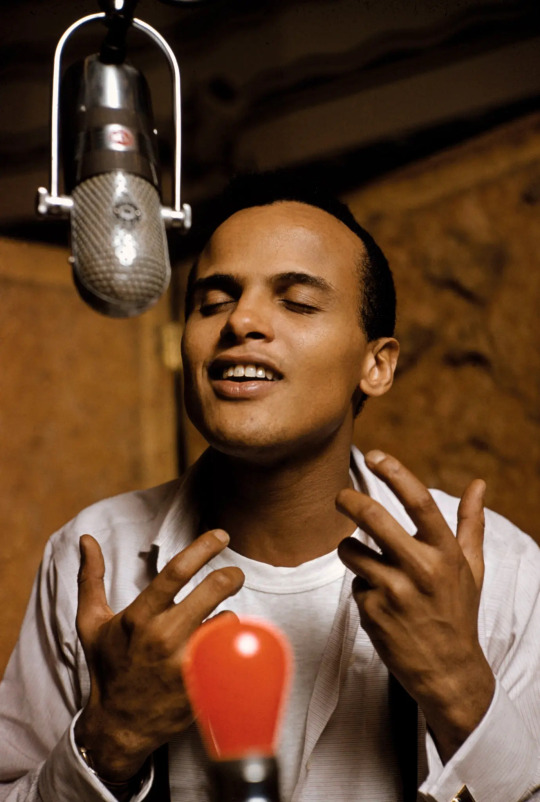
Harry Belafonte stormed the pop charts and smashed racial barriers in the 1950s with his highly personal brand of folk music, and went on to become a major force in the civil rights movement. Above, the singer in 1957.Credit...Bob Henriques/Magnum Photos
By Peter Keepnews
April 25, 2023Updated 10:40 a.m. ET
Harry Belafonte, who stormed the pop charts and smashed racial barriers in the 1950s with his highly personal brand of folk music, and who went on to become a dynamic force in the civil rights movement, died on Tuesday at his home on the Upper West Side of Manhattan. He was 96.
The cause was congestive heart failure, said Ken Sunshine, his longtime spokesman.
At a time when segregation was still widespread and Black faces were still a rarity on screens large and small, Mr. Belafonte’s ascent to the upper echelon of show business was historic. He was not the first Black entertainer to transcend racial boundaries; Louis Armstrong, Ella Fitzgerald and others had achieved stardom before him. But none had made as much of a splash as he did, and for a few years no one in music, Black or white, was bigger.
Born in Harlem to West Indian immigrants, he almost single-handedly ignited a craze for Caribbean music with hit records like “Day-O (The Banana Boat Song)” and “Jamaica Farewell.” His album “Calypso,” which included both those songs, reached the top of the Billboard album chart shortly after its release in 1956 and stayed there for 31 weeks. Coming just before the breakthrough of Elvis Presley, it was said to be the first album by a single artist to sell more than a million copies.
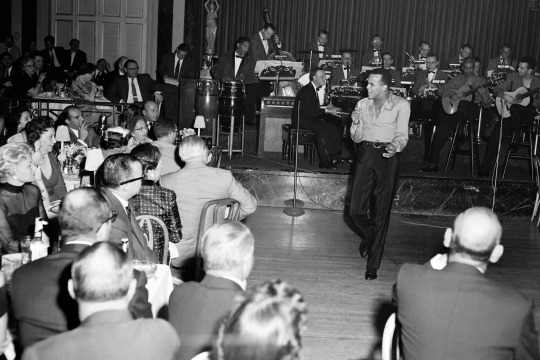
Performing at the Waldorf Astoria in New York in 1956.Credit...Al Lambert/Associated Press
Mr. Belafonte was equally successful as a concert attraction: Handsome and charismatic, he held audiences spellbound with dramatic interpretations of a repertoire that encompassed folk traditions from all over the world — rollicking calypsos like “Matilda,” work songs like “Lead Man Holler,” tender ballads like “Scarlet Ribbons.” By 1959 he was the most highly paid Black performer in history, with fat contracts for appearances in Las Vegas, at the Greek Theater in Los Angeles and at the Palace in New York.
Success as a singer led to movie offers, and Mr. Belafonte soon became the first Black actor to achieve major success in Hollywood as a leading man. His movie stardom was short-lived, though, and it was his friendly rival Sidney Poitier, not Mr. Belafonte, who became the first bona fide Black matinee idol.
But making movies was never Mr. Belafonte’s priority, and after a while neither was making music. He continued to perform into the 21st century, and to appear in movies as well (although he had two long hiatuses from the screen), but his primary focus from the late 1950s on was civil rights.
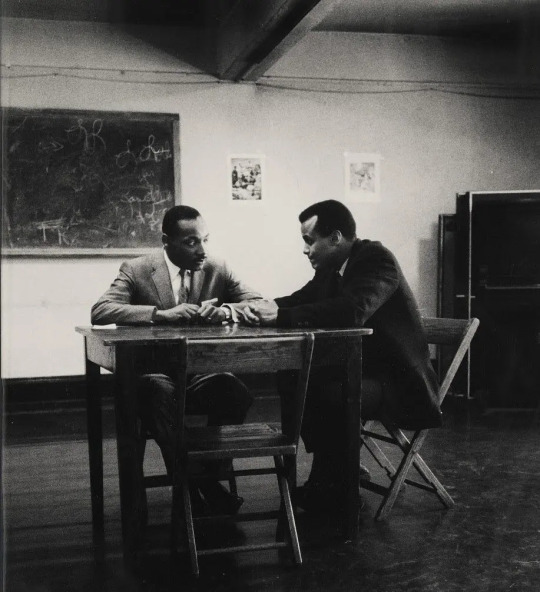
Early in his career, Mr. Belafonte befriended the Rev. Dr. Martin Luther King Jr. and became not just a lifelong friend but also an ardent supporter. Dr. King and Mr. Belafonte at the Abyssinian Baptist Church in Harlem in 1956.Credit...via Harry Belafonte.
Early in his career, he befriended the Rev. Dr. Martin Luther King Jr. and became not just a lifelong friend but also an ardent supporter of Dr. King and the quest for racial equality he personified. He put up much of the seed money to help start the Student Nonviolent Coordinating Committee and was one of the principal fund-raisers for that organization and Dr. King’s Southern Christian Leadership Conference.
He provided money to bail Dr. King and other civil rights activists out of jail. He took part in the March on Washington in 1963. His spacious apartment on West End Avenue in Manhattan became Dr. King’s home away from home. And he quietly maintained an insurance policy on Dr. King’s life, with the King family as the beneficiary, and donated his own money to make sure that the family was taken care of after Dr. King was assassinated in 1968.
(Nonetheless, in 2013 he sued Dr. King’s three surviving children in a dispute over documents that Mr. Belafonte said were his property and that the children said belonged to the King estate. The suit was settled the next year, with Mr. Belafonte retaining possession.)
In an interview with The Washington Post a few months after Dr. King’s death, Mr. Belafonte expressed ambivalence about his high profile in the civil rights movement. He would like to “be able to stop answering questions as though I were a spokesman for my people,” he said, adding, “I hate marching, and getting called at 3 a.m. to bail some cats out of jail.” But, he said, he accepted his role.
The Challenge of Racism
In the same interview, he noted ruefully that although he sang music with “roots in the Black culture of American Negroes, Africa and the West Indies,” most of his fans were white. As frustrating as that may have been, he was much more upset by the racism that he confronted even at the height of his fame.
His role in the 1957 movie “Island in the Sun,” which contained the suggestion of a romance between his character and a white woman played by Joan Fontaine, generated outrage in the South; a bill was even introduced in the South Carolina Legislature that would have fined any theater showing the film. In Atlanta for a benefit concert for the Southern Christian Leadership Conference in 1962, Mr. Belafonte was twice refused service in the same restaurant. Television appearances with white female singers — Petula Clark in 1968, Julie Andrews in 1969 — angered many viewers and, in the case of Ms. Clark, threatened to cost him a sponsor.
He sometimes drew criticism from Black people, including the suggestion early in his career that he owed his success to the lightness of his skin (his paternal grandfather and maternal grandmother were white). When he divorced his wife in 1957 and married Julie Robinson, who had been the only white member of Katherine Dunham’s dance troupe, The Amsterdam News wrote, “Many Negroes are wondering why a man who has waved the flag of justice for his race should turn from a Negro wife to a white wife.”
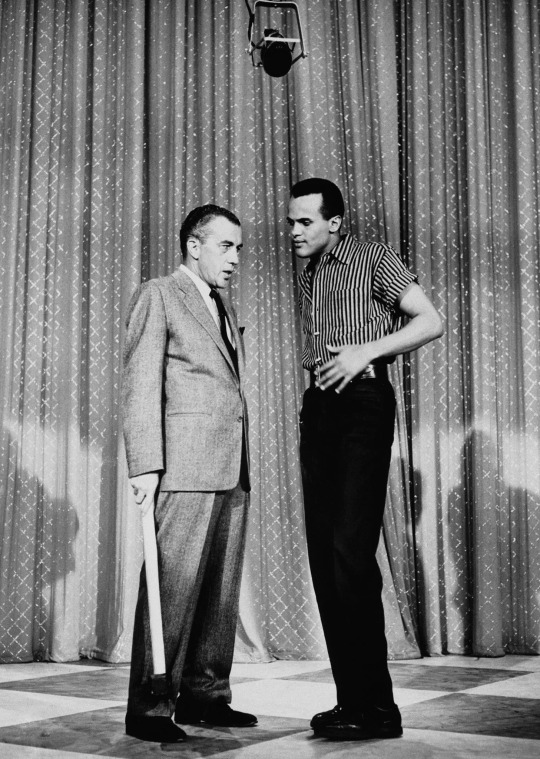
Mr. Belafonte with Ed Sullivan in 1955. At a time when segregation was still widespread and Black faces were still a rarity on screens large and small, Mr. Belafonte’s ascent to the upper echelon of show business was historic.Credit...Associated Press
When RCA Victor, his record company, promoted him as the “King of Calypso,” Mr. Belafonte was denounced as a pretender in Trinidad, the acknowledged birthplace of that highly rhythmic music, where an annual competition is held to choose a calypso king.
He himself never claimed to be a purist when it came to calypso or any of the other traditional styles he embraced, let alone the king of calypso. He and his songwriting collaborators loved folk music, he said, but saw nothing wrong with shaping it to their own ends.
“Purism is the best cover-up for mediocrity,” he told The New York Times in 1959. “If there is no change we might just as well go back to the first ‘ugh,’ which must have been the first song.”
Harold George Bellanfanti Jr. was born on March 1, 1927, in Harlem. His father, who was born in Martinique (and later changed the family name), worked occasionally as a chef on merchant ships and was often away; his mother, Melvine (Love) Bellanfanti, born in Jamaica, was a domestic.
In 1936, Harry, his mother and his younger brother, Dennis, moved to Jamaica. Unable to find work there, his mother soon returned to New York, leaving him and his brother to be looked after by relatives who, he later recalled, were either “unemployed or above the law.” They rejoined her in Harlem in 1940.
Awakening to Black History
Mr. Belafonte dropped out of George Washington High School in Upper Manhattan in 1944 and enlisted in the Navy, where he was assigned to load munitions aboard ships. Black shipmates introduced him to the works of W.E.B. Du Bois and other African American authors and urged him to study Black history.
He received further encouragement from Marguerite Byrd, the daughter of a middle-class Washington family, whom he met while he was stationed in Virginia and she was studying psychology at the Hampton Institute (now Hampton University). They married in 1948.
He and Ms. Byrd had two children, Adrienne Biesemeyer and Shari Belafonte, who survive him, as do his two children by Ms. Robinson, Gina Belafonte and David; and eight grandchildren. He and Ms. Robinson divorced in 2004, and he married Pamela Frank, a photographer, in 2008, and she survives him, too, along with a stepdaughter, Sarah Frank; a stepson, Lindsey Frank; and three step-grandchildren.
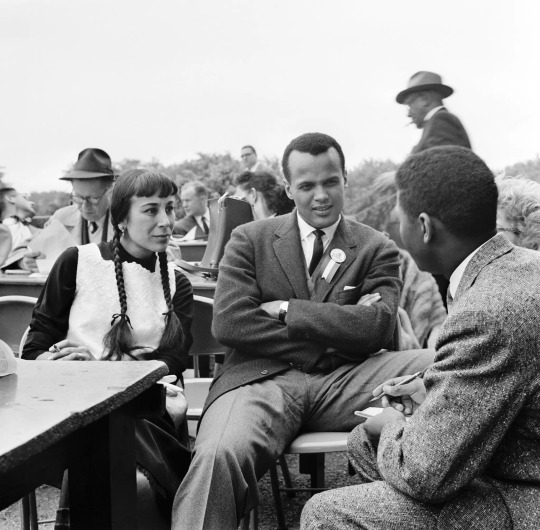
Mr. Belafonte and his wife, Julie, at the Prayer Pilgrimage for Freedom event in Washington in 1957.Credit...George Tames/The New York Times
Back in New York after his discharge, Mr. Belafonte became interested in acting and enrolled under the G.I. Bill at Erwin Piscator’s Dramatic Workshop, where his classmates included Marlon Brando and Tony Curtis. He first took the stage at the American Negro Theater in Manhattan, where he worked as a stagehand and where he began his lifelong friendship with a fellow theatrical novice, Sidney Poitier.
Finding anything other than what he called “Uncle Tom” roles proved difficult, and even though singing was little more than a hobby, it was as a singer and not an actor that Mr. Belafonte found an audience.
Early in 1949, he was given the chance to perform during intermissions for two weeks at the Royal Roost, a popular Midtown jazz nightclub. He was an immediate hit, and the two weeks became five months.
Finding Folk Music
After enjoying some success but little creative satisfaction as a jazz-oriented pop singer, Mr. Belafonte looked elsewhere for inspiration. With the guitarist Millard Thomas, who would become his accompanist, and the playwright and novelist William Attaway, who would collaborate on many of his songs, he immersed himself in the study of folk music. (The calypso singer and songwriter Irving Burgie later supplied much of his repertoire, including “Day-O” and “Jamaica Farewell.”)
His manager, Jack Rollins, helped him develop an act that emphasized his acting ability and his striking good looks as much as a voice that was husky and expressive but, as Mr. Belafonte admitted, not very powerful.
A triumphant 1951 engagement at the Village Vanguard in Greenwich Village led to an even more successful one at the Blue Angel, the Vanguard’s upscale sister room on the Upper East Side. That in turn led to a recording contract with RCA and a role on Broadway in the 1953 revue “John Murray Anderson’s Almanac.”

Dorothy Dandridge and Mr. Belafonte in a scene from the 1954 film “Carmen Jones.”Credit...20th Century Fox
Performing a repertoire that included the calypso standard “Hold ’em Joe” and his arrangement of the folk song “Mark Twain,” Mr. Belafonte won enthusiastic reviews, television bookings and a Tony Award for best featured actor in a musical. He also caught the eye of the Hollywood producer and director Otto Preminger, who cast him in the 1954 movie version of “Carmen Jones,” an all-Black update of Bizet’s opera “Carmen” with lyrics by Oscar Hammerstein II, which had been a hit on Broadway a decade earlier.
Mr. Belafonte’s co-star was Dorothy Dandridge, with whom he had also appeared the year before in his first movie, the little-seen low-budget drama “Bright Road.” Although they were both accomplished vocalists, their singing voices in “Carmen Jones” were dubbed by opera singers.
Mr. Belafonte also made news for a movie he turned down, citing what he called its negative racial stereotypes: the 1959 screen version of “Porgy and Bess,” also a Preminger film. The role of Porgy was offered instead to his old friend Mr. Poitier, whom he criticized publicly for accepting it.
Stepping Away From Film
In the 1960s, as Mr. Poitier became a major box-office attraction, Mr. Belafonte made no movies at all: Hollywood, he said, was not interested in the socially conscious films he wanted to make, and he was not interested in the roles he was offered. He did, however, become a familiar presence — and an occasional source of controversy — on television.
His special “Tonight With Belafonte” won an Emmy in 1960 (a first for a Black performer), but a deal to do five more specials for that show’s sponsor, the cosmetics company Revlon, fell apart after one more was broadcast; according to Mr. Belafonte, Revlon asked him not to feature Black and white performers together. The taping of a 1968 special with Petula Clark was interrupted when Ms. Clark touched Mr. Belafonte’s arm, and a representative of the sponsor, Chrysler-Plymouth, demanded a retake. (The producer refused, and the sponsor’s representative later apologized, although Mr. Belafonte said the apology came “one hundred years too late.”)

Mr. Belafonte addressed a civil rights rally in New York City in May 1960.Credit...Jacob Harris/Associated Press
When Mr. Belafonte returned to film as both producer and co-star, with Zero Mostel, of “The Angel Levine” (1970), based on a story by Bernard Malamud, the project had a sociopolitical edge: His Harry Belafonte Enterprises, with a grant from the Ford Foundation, hired 15 Black and Hispanic apprentices to learn filmmaking by working on the crew. One of them, Drake Walker, wrote the story for Mr. Belafonte’s next movie, “Buck and the Preacher” (1972), a gritty western that also starred Mr. Poitier.
But after appearing as a mob boss (a parody of Marlon Brando’s character in “The Godfather”) with Mr. Poitier and Bill Cosby in the hit 1974 comedy “Uptown Saturday Night” — directed, as “Buck and the Preacher” had been, by Mr. Poitier — Mr. Belafonte was once again absent from the big screen, this time until 1992, when he played himself in Robert Altman’s Hollywood satire “The Player.”
He appeared onscreen only sporadically after that, most notably as a gangster in Mr. Altman’s “Kansas City” (1996), for which Mr. Belafonte won a New York Film Critics Circle Award. His final film role was in Spike Lee’s “BlacKkKlansman” in 2018.
Political Activism
Mr. Belafonte continued to give concerts in the years when he was off the screen, but he concentrated on political activism and charitable work. In the 1980s, he helped organize a cultural boycott of South Africa as well as the Live Aid concert and the all-star recording “We Are the World,” both of which raised money to fight famine in Africa. In 1986, encouraged by some New York State Democratic Party leaders, he briefly considered running for the United States Senate. In 1987, he replaced Danny Kaye as UNICEF’s good-will ambassador.
Never shy about expressing his opinion, he became increasingly outspoken during the George W. Bush administration. In 2002, he accused Secretary of State Colin L. Powell of abandoning his principles to “come into the house of the master.” Four years later he called Mr. Bush “the greatest terrorist in the world.”
Mr. Belafonte was equally outspoken in the 2013 New York mayoral election, in which he campaigned for the Democratic candidate and eventual winner, Bill de Blasio. During the campaign he referred to the Koch brothers, the wealthy industrialists known for their support of conservative causes, as “white supremacists” and compared them to the Ku Klux Klan. (Mr. de Blasio quickly distanced himself from that comment.)
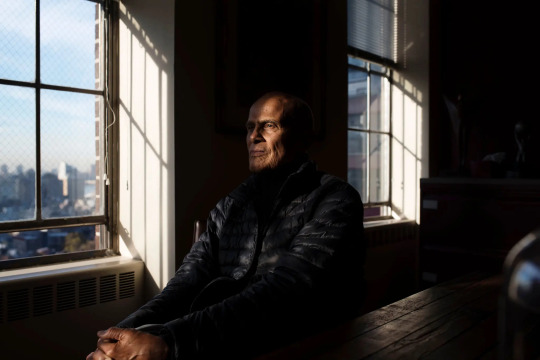
Looking back on his life and career, Mr. Belafonte was proud but far from complacent. “About my own life, I have no complaints,” he wrote in his autobiography. “Yet the problems faced by most Americans of color seem as dire and entrenched as they were half a century ago.”Credit...Karsten Moran for The New York Times
Such statements made Mr. Belafonte a frequent target of criticism, but no one disputed his artistry. Among the many honors he received in his later years were a Kennedy Center Honor in 1989, the National Medal of Arts in 1994 and a Grammy lifetime achievement award in 2000.
In 2011, he was the subject of a documentary film, “Sing Your Song,” and published his autobiography, “My Song.”
In 2014, the Academy of Motion Picture Arts and Sciences gave him its Jean Hersholt Humanitarian Award in recognition of his lifelong fight for civil rights and other causes. The honor, he told The Times, gave him “a strong sense of reward.”
He remained politically active to the end. On Election Day 2016, The Times published an opinion article by Mr. Belafonte urging people not to vote for Donald J. Trump, whom he called “feckless and immature.”
“Mr. Trump asks us what we have to lose,” he wrote, referring to African American voters, “and we must answer: Only the dream, only everything.”
Four years later, he returned to the opinion pages with a similar message: “We have learned exactly how much we had to lose — a lesson that has been inflicted upon Black people again and again in our history — and we will not be bought off by the empty promises of the flimflam man.”
Looking back on his life and career, Mr. Belafonte was proud but far from complacent. “About my own life, I have no complaints,” he wrote in his autobiography. “Yet the problems faced by most Americans of color seem as dire and entrenched as they were half a century ago.”
Richard Severo and Alex Traub contributed reporting.
0 notes
Photo

Flashback to when my bride and I were interviewed by @insideweddings for her stunning feature. See what she said below.... In order to achieve the elevated look Meagan envisioned, the bride decided to exclude tablecloths. “[That choice] made the room look more balanced and high-end,” she illustrates. Tall, impressive centerpieces adorned tables, as well as glass candelabras, which helped to set the mood. “I wanted our guests to walk in and really be blown away. When I walked in, my heart stopped,” admits the bride. . . Planning & Design: @andreaeppolito Photo @adamfrazierphotographer Floral @javier_valentino Rentals @palacepartyrental Venue @walasvegas . . . . #insideweddings #weddingtable #weddingtablescape #weddingtabledecor #weddingtables #weddingtabledesign #weddingtabledecoration #orchidweddingflowers #whiteweddings #whitewedding #weddingflowers #modernwedding #vegaswedding #vegasweddings #lasvegaswedding #lasvegasweddings #weddingreceptiondecor #receptiondetails #weddingflowersdecor #weddingflowerdecor #vivalasouradas (at Waldorf Astoria Las Vegas) https://www.instagram.com/p/CqBUboLPtgK/?igshid=NGJjMDIxMWI=
#insideweddings#weddingtable#weddingtablescape#weddingtabledecor#weddingtables#weddingtabledesign#weddingtabledecoration#orchidweddingflowers#whiteweddings#whitewedding#weddingflowers#modernwedding#vegaswedding#vegasweddings#lasvegaswedding#lasvegasweddings#weddingreceptiondecor#receptiondetails#weddingflowersdecor#weddingflowerdecor#vivalasouradas
0 notes
Photo

Slot Joynt, 1982. A gift shop on the property of a Holiday Inn at 3740 S Las Vegas Blvd was turned into this casino in the late 70s. This later expanded into a strip mall-style casino, then into Boardwalk Hotel & Casino. Present site of Waldorf Astoria at City Center.
Photo by John S. Stec. Society of Architectural Historians, UC Riverside and Gluck Program, Artsor.
34 notes
·
View notes
Text

Harold Ramis during The American Museum of the Moving Image Salute to Billy Crystal at The Waldorf Astoria in New York City, United States. (Photo by Stephen Lovekin/FilmMagic)

Director Harold Ramis with sons during "Analyze That" World Premiere (2002)- Inside Arrivals at Ziegfeld Theatre in New York City, New York, United States. (Photo by Dimitrios Kambouris/WireImage)

(06/20/09-Nantucket,MA) The 14th annual Nantucket Film Festival continues until Sunday. Here, Harold Ramis ..at the festival's tribute to…. Harold Ramis. (Photo by Mark Garfinkel/MediaNews Group/Boston Herald via Getty Images)

Billy Crystal and Harold Ramis during 1995 ShoWest in Las Vegas, Nevada, United States. (Photo by Jeff Kravitz/FilmMagic, Inc)

Harold Ramis and Albert Berger during Anonymous Content 2004 Holiday Party in Culver City, California, United States. (Photo by J.Sciulli/WireImage for BWR Public Relations)
Gooooood eveniiiiing Harold Nation!
I bring forth more pics of "Silver Fox" Ramis himself!
Proof that repetitive internet searching will still yet yield new fruit!
Enjoy!
8 notes
·
View notes
Text
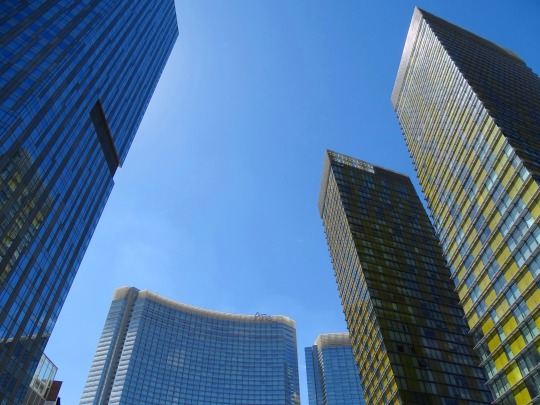

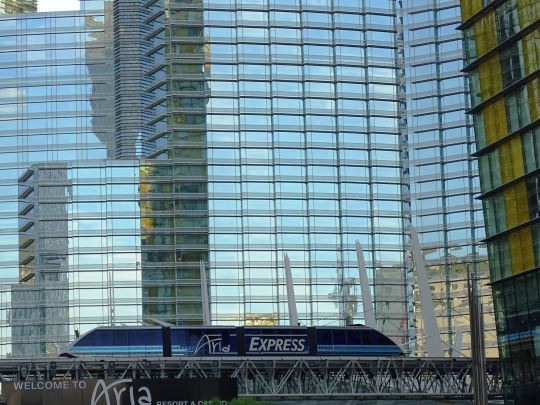


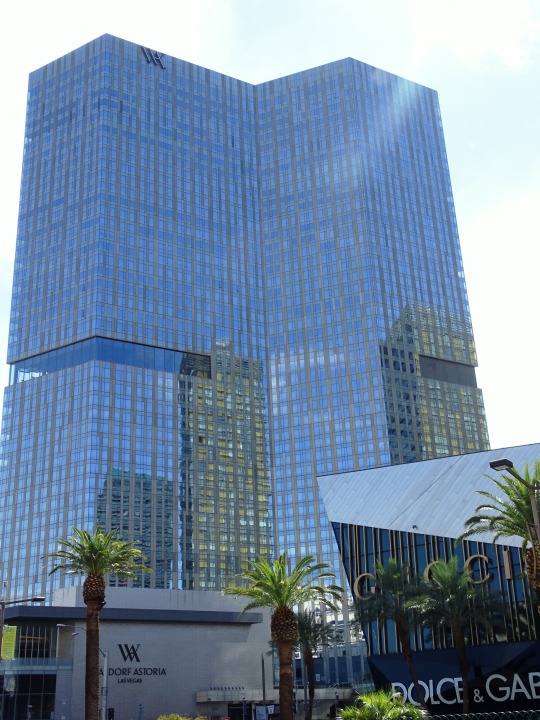



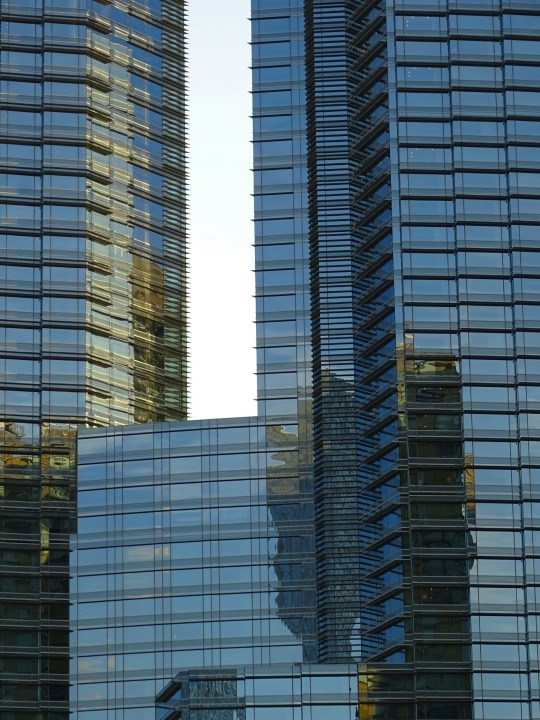

Waldorf Astoria Las Vegas
The Waldorf Astoria Las Vegas, formerly the Mandarin Oriental, Las Vegas, is a 47-story luxury hotel and condominium building in the CityCenter complex on the Las Vegas Strip in Paradise, Nevada. It is managed by Hilton Worldwide as part of the Waldorf Astoria Hotels & Resorts brand. It is owned by Tiffany Lam and Andrew and Peggy Cherng.
The hotel was originally owned by MGM Mirage and Dubai World, and operated by Mandarin Oriental Hotel Group as part of its luxury chain. It opened on December 4, 2009, occupying the former site of the Boardwalk hotel-casino. It was rebranded under the Waldorf Astoria name in 2018, following a $214 million purchase by Lam and the Cherngs. The hotel has 389 rooms leading up to the lobby on the 23rd floor. The upper floors contain 225 condominium residences.
Source: Wikipedia
Aria Resort and Casino
Aria Resort and Casino is a luxury resort and casino, and the primary property at the CityCenter complex, located on the Las Vegas Strip in Paradise, Nevada. It is owned by The Blackstone Group and operated by MGM Resorts International.
Construction began on June 25, 2006, with a design by Pelli Clarke Pelli Architects. Aria received LEED Gold certification for its environmentally friendly design, and is the largest hotel in the world to achieve such a feat. It was also among the most technologically advanced hotels in the world at the time of its opening on December 16, 2009. It was developed as a joint venture between MGM and Dubai World, before being sold to Blackstone in 2021.
Aria's hotel includes two curvilinear glass towers, rising up to 50 stories. The hotel has 4,004 rooms and suites, and is a recipient of the AAA Five Diamond Award and a five-star rating from Forbes Travel Guide. The resort also includes the only casino at CityCenter, with 150,000 sq ft (14,000 m2) of gaming space. Other features include an 80,000 sq ft (7,400 m2) salon and spa, 500,000 sq ft (46,000 m2) of convention space, and numerous restaurants, as well as artwork and water attractions.
Source: Wikipedia
#Waldorf Astoria Las Vegas#3752 South Las Vegas Boulevard#Kohn Pedersen Fox#Aria Resort and Casino#3730 South Las Vegas Boulevard#Pelli Clarke Pelli Architects#Veer Towers#exterior#Paradise#travel#original photography#vacation#tourist attraction#landmark#summer 2022#USA#cityscape#Nevada#architecture#reflection#palm tree#street scene#night shot#detail#façade#Clark County#neon sign
0 notes
Text
7 Standout Vegas Spas With Ideal Cannabis Pairings

Las Vegas is known as Sin City for a reason. A trip to the famous Strip usually means that any efforts to practice “everything in moderation” quickly get thrown out the window. Whether it’s hours spent gambling, gorging at world-class buffets, or shopping lavishly, Vegas is truly a destination defined by indulgence. But if you’re looking to stay busy with activities that are far more relaxing than spending the night at the blackjack tables, Vegas also offers an impressive selection of spa experiences.
Hours spent at a luxurious spa might be one of the best ways to indulge yourself, especially if you want to do something that’s a marked departure from the usual hedonistic Vegas activity. Even better? The right cannabis pairing can only enhance your spa stint. Quick tip: Opt for more relaxing strains, like indicas or hybrids, or products with high CBD. (Save those sativas for situations where you’ll need ample energy, like hitting up the slots or finally trying the zipline on Fremont Street.)
Below, seven of the best Las Vegas spas worth booking a service (or two), with MedMen products to match.
Las Vegas Cannabis Spa Ideas
Sahra Spa & Hammam at The Cosmopolitan Walking through this 50,000 square foot spa will immediately have you feeling like you’ve teleported to another time and place, thanks to a luxurious hammam treatment room, modeled after the Turkish baths. Book the Moroccan Journey, a 130-minute body care service that includes a buff and scrub with a traditional kese mitt, detoxifying rhassoul clay mud masque, and the full-body Sahra Signature Massage.
MedMen pairing: Fleur Cannabis Pre-Roll This sweet-tasting, indica dominant strain can help ease you into sleep after the relaxing hammam treatment.
The Spa and Salon at ARIA This award-winning spa features private suites, a Shio salt room, and heated Japanese stone beds that will soothe your muscles after hours walking on the strip. If you (and your wallet) can handle extreme spa experiences, you can book the $1,000 Majestic Canyon Collagen Facial, a collaboration with skincare brand Valmont Cosmetics.
MedMen pairing: Birthday Cake Bar Is there anything more indulgent than a chocolate bar? A fancy edible goes perfectly well with this luxe treatment.
The Spa at Encore A destination all its own, the Spa at Encore features 51 treatment rooms, including over two dozen garden suites that can host two people simultaneously. If the Vegas debauchery has you feeling worn out, treat yourself to a spa service that focuses on energy work, such as the Bodhi Massage and Visualization, which aims to balance the body’s seven Chakras.
MedMen pairing: Matrix Do-Si-Dos A few hits of this euphoric indica will help prepare you for this incredible body care treatment.
The Spa at Waldorf Astoria The Waldorf Astoria name is synonymous with truly topnotch spas, so make sure to carve out some extra time to hang out before and after your service. It features an herbal steam room, vitality pool, hammam, ice fountain, relaxation lounges, laconium (a dry sweat room), and a total of 16 treatment rooms. Book a healing jade stone massage to bring balance to your tired body, and maybe save room for Waldorf salad?
MedMen pairing: [statemade] zen It’s all in the name, right? Here’s the perfect strain to help you find inner peace.
Qua Baths & Spa at Caesars Palace Las Vegas Hotel and Casino Three words: Arctic Ice Room. Yes, this spa has a room where you sit on a heated bench and inhale mint-infused air while “snow” gently falls. It also has three Roman baths set at varying temperatures, a laconium, and an entire room dedicated to Swarovski crystal body art applications so you can leave with some bling. Try the Qua Signature Mojave Rain service which begins with a sage smudging (to get rid of any bad energy) and includes a stress-relieving massage and balancing energy work.
MedMen pairing: Desert Grown Farms Dark Wizard #1 Say goodbye to stress ASAP with this mood-lifting, body-relaxing strain before your treatment.
ESPA at Vdara If you’re looking for a spa that is also green, ESPA at Vdara is your best bet. It’s LEED Gold-certified, meaning it uses mostly organic skin care products and uses water-saving showers. Want a treatment specifically aimed at easing muscle pain from workouts? Try the Strength & Resilience Massage, which uses yogic stretches and deep muscle massage to get your body back on track.
MedMen pairing: CannaHemp Elixir CBD in Relief This CBD tincture eases aches, complementing this type of massage service perfectly.
Bellagio Spa & Salon At the Bellagio’s spa, you can choose from an array of wanderlust-themed body treatments services, ranging from Italian-themed to inspired by Polynesian healers. Other amenities include a private heated Watsu pool, steam room, cold plunge pool, and three whirlpools.
MedMen pairing: Binske Honduran Raspberry Dark Chocolate To go with the spa’s world traveler theme, this cannabis-infused chocolate contains cacao that’s been grown in the same Honduran jungle sacred to the Mayans.
If you’re looking for cannabis in Las Vegas visit to you nearest cannabis dispensary in Las Vegas.
#Las Vegas Cannabis Spa Ideas#cannabis in Las Vegas#cannabis dispensary in Las Vegas#Vegas Spas With Ideal Cannabis Pairings#The Spa at Waldorf Astoria#marijuana dispensary in las vegas#spas product in las vegas#dispensary in las vegas
0 notes
Photo

The Baumans, Sellers of Really, Really Rare Books
Their shop is the thinking person’s place to go after hitting the jackpot in Las Vegas (or New York).
What reward does one buy after winning at the gambling tables in Las Vegas or sitting through an excruciatingly dull convention there? A Rolex, a designer handbag, a new bracelet?
How about a rare book?
It was 11 years ago that David and Natalie Bauman, the owners of a successful rare book store in Manhattan, open since 1988, decided to expand to Las Vegas, opening a store on a relatively quiet second floor walkway among the Grande Canal Shoppes between the Venetian and Palazzo hotels. On the main floor, ersatz gondolas with gondoliers ferry tourists from end to end.
Their shop is wedged next to Lazarou, a custom men’s clothing store, and just across from Mezlan, which sells shoes. Its two-story, elegant bookcases are filled with carefully arranged volumes, many bound in embossed leather. A reading table at the center of the store recalls an Ivy League college library. A patient saleswoman awaits visitors at a podium close to the entrance.
On a recent day, in a locked vitrine, were first editions of Lewis Carroll’s “Alice’s Adventures in Wonderland” and “Through the Looking-Glass” in full leather pictorial bindings. Printed in 1866 and 1872, they sell together for $23,000. For $700 one could by a first edition of Margaret Thatcher’s “The Path to Power,” signed by her.
In a town of sparkle and flash, rare books are an anomaly, but for the Baumans, they are lucrative. One visitor spent $400,000 on “The Great Gatsby” and McKenney and Halls’ “History of the Indian Tribes of North America” in a single visit. Another, a quiet man in shorts, flip-flops and a T-shirt spent $15,000 on a first edition of “Huckleberry Finn” and then several weeks later returned to pick out a first edition of “The Catcher in the Rye” for $17,000. (One can only imagine what Holden Caulfield would think of that.)
But most receipts are well under $1,000, Ms. Bauman said. Julia Child’s “Mastering the Art of French Cooking” is a bargain at $850, and a 1996 first edition of Chuck Palahniuk’s “Fight Club” goes for about $1,000.
One Las Vegas visitor started with modest purchases. Then he became fascinated with Gould’s “Birds of Great Britain” an ornithological plate book that contains a series of spectacular plates, colored by hand, plunking down $100,000.
Later he paid $500,000 for a first edition of Isaac Newton’s “Principia.”
“Most People Don’t Look Up”
The couple got into rare books quite by accident, recalled David Bauman, a gentle, soft-spoken man in his 70s, after espying some at Freeman, the auction house in Philadelphia where they lived as newlyweds. “For $1 we bought a first edition of a volume of Samuel Johnson’s works, then we bought a first edition of James Joyce’s “Ulysses” for $12, and we started to think about it as a business,” he said. “We were not afraid then, because we did not know enough to be afraid.”
They opened a small store on the second floor of a building across the street from Freeman’s. “But what we did not realize is that most people don’t look up,” Mr. Bauman said.
So they decided to go to antique shows around the country selling books. They eschewed New York because “we were told it was just terrifying,” Natalie Bauman said. “But when we finally came to the city, we made more money in one day as we made in six months going around the country.”
They next set up shop at the Waldorf Astoria, because “you want to put yourself where the kind of people who buy your books will go,’’ Mrs. Bauman said. Easy enough, right?
Nope.
“The first week, we did not sell any books. No one even came into the store,” she recalled. But then Nelson Doubleday appeared. Mr. Doubleday had been chairman of Doubleday and Co., his family’s business but had sold it for hundreds of millions. “He looked around and bought half of our inventory and had it shipped to his yacht. He was also the godson of Rudyard Kipling,” Mr. Bauman said.
Eleven years later, the Baumans decided to open at 535 Madison Avenue, where they remain, after walking up and down the blocks there to evaluate the market. “Mostly businessmen,” Mr. Bauman said.
One day, two women from the Midwest walked into the store. “We came to New York to see different, great things and there is magic in your store,” one told Mrs. Bauman.
Some years later her husband went to visit a cousin working on a project in Las Vegas. “I realized that there was over one million feet of convention space underneath the hotels,” he said. “Casinos have studied everything about their customers. They were making more money from the stores than from the casinos.”
He realized that the millions of visitors who arrive in Las Vegas each year “are there to enjoy themselves. They have the time to look at books and put a toe in the water. When you are on vacation, you have more discretionary income and more time to spend it.”
Buzz Aldrin’s Teletype
Still, for the Baumans, opening in Vegas was a big investment. They wanted a store that had the elegance of a wonderful library. ”We believe we sell beautiful things so they should be housed in a beautiful place,” Mr. Bauman said. The store also required a staff of nine people, since it is generally open 13 hours a day.
Its sales staff has to be very knowledgeable. “He would quiz us,” Eric Pederson, who now manages the Manhattan store, said. “David would point to a book and ask us to tell us everything we knew about it.” Today a 32-person staff works in New York, Las Vegas and Philadelphia, where much of the research and online business takes place.
Over time experts learn what makes a book valuable. For example, Mr. Pederson explained, the earliest copies of the first edition of Ernest Hemingway’s “The Sun Also Rises” said “author of ‘In Our Times’” on the dust jacket. “You had to know it was an error that was soon “corrected to “In Our Time.” “The mistake told you that book was an earlier copy.”
Initial printings of “Huckleberry Finn” had errors as well. On page 57 a sentence read: “With his was …” because the letters for the word “saw” had been reversed. In later printings it was corrected to: “With his saw.”
And a copy of “Ulysses” signed by both James Joyce and Henri Matisse was printed before their dispute because Joyce grew upset when he realized that Matisse had relied on Homer’s “Odyssey” as a source of inspiration, rather than Joyce’s “Ulysses.”
But erudition is not enough to keep the Baumans afloat. Marketing and event planning are equally important. In July 2009, the 40th anniversary of the first moon landing, the store promoted a group of space exploration books including Buzz Aldrin’s Teletype message of the safe touchdown, which he later signed, six volumes of limited editions by astronauts including John Glenn and Scott Carpenter. For a nice stocking stuffer one year, the Baumans offered a first edition of Charles Dickens’s “A Christmas Carol,” published in 1843. The price: $38,000.
For gamblers who pray to win, and may need a little help, the store had offered an exhibit of rare bibles like a fragment of the microform containing 50 pages of the King James Bible. Three years ago, it held an exhibit of cookbooks, including the first Jewish one published in America.
The Baumans, who spend most of their time in New York and a 12,000-square-foot headquarters in Philadelphia, remain obsessed by books. “When we are going on vacation, we have to pick a place with no bookshops,” Mr. Bauman said. “We like Thailand, Vietnam and Turkey: Turkey because you could not buy and take away old Qurans because they are antiquities. So all we could buy was fabric.”
Their success in Las Vegas has been “a pleasant surprise,” he said, with a few unexpected advantages.
For example, the city attracts more than 42 million visitors a year, but the average stay is only three and a half days. “You don’t have to change your windows very often,” Mr. Bauman said.
Tiny details and the aesthetics aren’t merely a side note, they’re as important as anything else.
Daily inspiration. Discover more photos at http://justforbooks.tumblr.com
29 notes
·
View notes
Text
Vegas Swirl
The Aria, Shops at Crystals, Veer Towers and Waldorf-Astoria stretch into the sky at Las Vegas’ CityCenter.

View On WordPress
#Architecture#Aria Resort & Casino#CityCenter#Color#Mandarin Oriental#Nevada#Sky#The Shops at Crystals#Veer Towers
1 note
·
View note
Text
It’s 5 in the morning where I live, I have not slept, and I am dubiously coherent.
And yes, I do fully intend to talk about some small aspects of the Batman AU I’ve been holding off on talking about on Tumblr because people sure do like to steal ideas and then be awfully rude about it. And also character designs. Mostly character designs. So, buckle up. Or do not. I am likely not putting this in the main tags. Disjointed rambling ahead.
There are a few words to describe what I’ve ended up doing to this questionable AU of an AU version of Gotham City [it’s Holy Musical B@man!, but don’t ask...unless you desire to], and those are cramped, crowded, and deliriously looming. Near everything goes straight up to the skyline here, and I take inspiration from the Las Vegas Strip in that there's often several establishments housed in the same general building structure, stacked on top of one another; my Riddler in particular lives in a penthouse on top of several bars and attached restaurants, as well as Pandora’s Box. Think Showcase Mall in particular and that whole section of the Strip, if you’ve ever been to Vegas or even seen pictures. It’s oppressive, and it’s angular. That's precisely why Rogues like Basil Karlo/Clayface 1 are able to inflict a devastating amount of damage in such a short amount of time; almost everything is stacked together like Jenga. Literally, my Gotham is a tourist city/town at its finest. As such, lights, color, and sound make up a fair portion of it. Lots of duck architecture as well, things are a blend of larger cities such as San Francisco/Las Vegas/New York. Any hotels are fancy and range from having St. Regis Saadiyat Island to Waldorf-Astoria to Four Seasons energy. It's all about the glitz, it's ultimately for the tourists. Suburbs and industrial areas both are away from the more bustling area because people do need to sleep; despite the narrow, crowded city streets there’s a lot of open space once you get away from the bulk of the thing. Houses are almost always attached to each other and are typically low to the ground, and built from brick or brownstone usually. No crazy colors either; think earth tones or heavily desaturated greens and blues. Things are upkept almost too well, to the point where at times the city can seem staged. Like someone’s idealized version of a city. I wanted to play off the "haha this is [literally] all staged" concept that I know the Langs did not want me to take literally, because I thought that would be fun. It also never gets completely dark out, in a meta sense riffing off the fact that overall this AU is lighter and a lot more silly than most fanon I’ve seen. Still deals with potentially concerning themes such as assault and infidelity, however. Also there’s an immortal shapeshifter that eats people who the rest of the Rogues Gallery just try to ignore because they don’t want to piss him off next. Kind of can’t ignore him though.
2 notes
·
View notes
Photo

Las Vegas (en Waldorf Astoria Las Vegas) https://www.instagram.com/p/B_DQ9lZq99M/?igshid=elsot4u66o23
3 notes
·
View notes